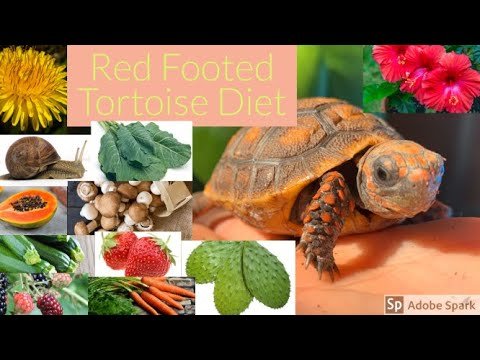
Before you dive into the specifics, let me tell you a bit about the red-footed tortoise itself. Native to South America, this tortoise prefers a moist, tropical climate, making it essential to mimic its natural environment as closely as possible—especially when it comes to food. Now, whether you’re a new tortoise owner or you’ve had your shelled friend for a while, understanding how to feed your red-footed tortoise can help ensure a long, healthy life.
Understanding the Red-Footed Tortoise’s Diet
Red-footed tortoises are omnivores, which means they enjoy a mix of plant-based foods and protein. Think of their diet as a colorful plate filled with greens, fruits, and occasional animal protein. It’s like creating a vibrant salad topped with a side of protein. Their natural diet consists primarily of fruits, flowers, and leaves, all of which keeps them healthy and happy.
Here are some key components of their diet:
- Leafy Greens: Dark, leafy greens like kale, collard greens, and dandelion greens should make up a significant portion of their diet. These are packed with essential vitamins and minerals.
- Fruits: Treat them to occasional fruits such as mango, papaya, and strawberries. Just like us, they enjoy a little sweetness now and then!
- Vegetables: Squash and carrots can offer some variety and nutrients, but they should be given in moderation to avoid digestive issues.
- Protein Sources: You can mix in small amounts of protein like insects or even lean meats, but this should only be a small part of their overall diet.
Feeding your tortoise a balanced diet keeps them active and vibrant. So, let’s explore how you can create this delicious meal plan.
How Often Should You Feed Your Red-Footed Tortoise?
You might be wondering how often to fill that colorful plate. Generally, red-footed tortoises should be fed daily, especially when they are young and growing. Think of it like this: just as a child needs regular meals for energy, baby tortoises need consistent feeding for growth.
For adult tortoises, the feeding frequency can be slightly different. You can feed them every other day or three times a week. Here’s a simple way to remember this:
- Juveniles: Daily feeding is best to support growth.
- Adults: Every other day or 3 times a week keeps them satisfied without overfeeding.
Always observe your tortoise’s appetite. If they seem uninterested in food, it could be a sign they need a change in their diet or even a checkup with a vet.
Tips for Preparing Their Meals
Now that you know what to feed your red-footed tortoise and how often, let’s talk about the fun part: preparing their meals! You want the food to be appealing and nutritious. Here’s how to make meal prep a breeze:
1. Chop It Up: Red-footed tortoises may have a hard time chewing on large pieces. Chop their greens and vegetables into bite-sized pieces. This helps them eat easier and reduces waste.
2. Mix It Up: Variety is essential. Rotate different types of greens, fruits, and veggies throughout the week. This keeps your tortoise excited about mealtime—just like when you enjoy a diverse menu!
3. Freshness Matters: Always serve fresh food. Spoiled greens can lead to health issues, so keep an eye on what’s in their bowl. If it looks wilted or smells off, toss it out.
4. Think Hydration: Make sure to offer fresh water daily. Sometimes, tortoises forget to drink if they’re munching away. Just like us, they need to stay hydrated!
By following these tips, you’ll not only make feeding time more enjoyable for your tortoise, but you’ll also help them absorb nutrients better.
Signs of a Balanced Diet
So, how can you tell if your red-footed tortoise is enjoying a balanced diet? There are a few signs to look out for. A healthy tortoise will have:
- Vibrant Colors: A bright, colorful shell often indicates good health. Dull colors might mean nutritional deficiencies.
- Active Behavior: If your tortoise is moving around and exploring, it’s a good sign they’re feeling well.
- Healthy Shell Growth: Regular shell growth and shedding suggest proper nutrition. Keep an eye on any abnormal bumps or indentations.
- Consistent Waste: Look for firm, well-formed droppings. Loose stools can indicate digestive issues, which might relate to diet.
If you notice any unusual changes in behavior or appearance, don’t hesitate to consult a veterinarian. After all, a healthy tortoise equals a happy owner!
Common Feeding Mistakes to Avoid
When feeding your red-footed tortoise, even well-meaning owners can make a few common mistakes. Here are some pitfalls to dodge:
1. Overfeeding: It might be tempting to give your tortoise extra treats, but overfeeding can lead to obesity. Stick to a proper portion, especially with high-calorie fruits.
2. Ignoring Calcium Needs: Calcium is essential for shell health. Make sure to offer a calcium supplement or foods rich in calcium like dark leafy greens. Just like us, they need building blocks to grow strong!
3. Unbalanced Diet: Avoid feeding them only one type of food. A varied diet is crucial to prevent nutritional deficiencies.
4. Using Toxic Plants: Some plants are harmful to tortoises, such as azaleas and daffodils. Always research any new plants before including them in your tortoise’s diet.
By avoiding these mistakes, you’re setting your red-footed tortoise up for success. It’s all about finding that balance!
Feeding your red-footed tortoise doesn’t have to be rocket science. With a bit of understanding and effort, you can create a vibrant, nutritious menu that keeps your shelled friend happy and healthy. Remember to focus on variety, freshness, and balance, and you’ll be well on your way to providing the best care possible.
By following these guidelines, you not only ensure that your tortoise eats well, but also foster a bond built on love and care. So, roll up your sleeves, put on your apron, and enjoy the rewarding journey of feeding your red-footed tortoise!
